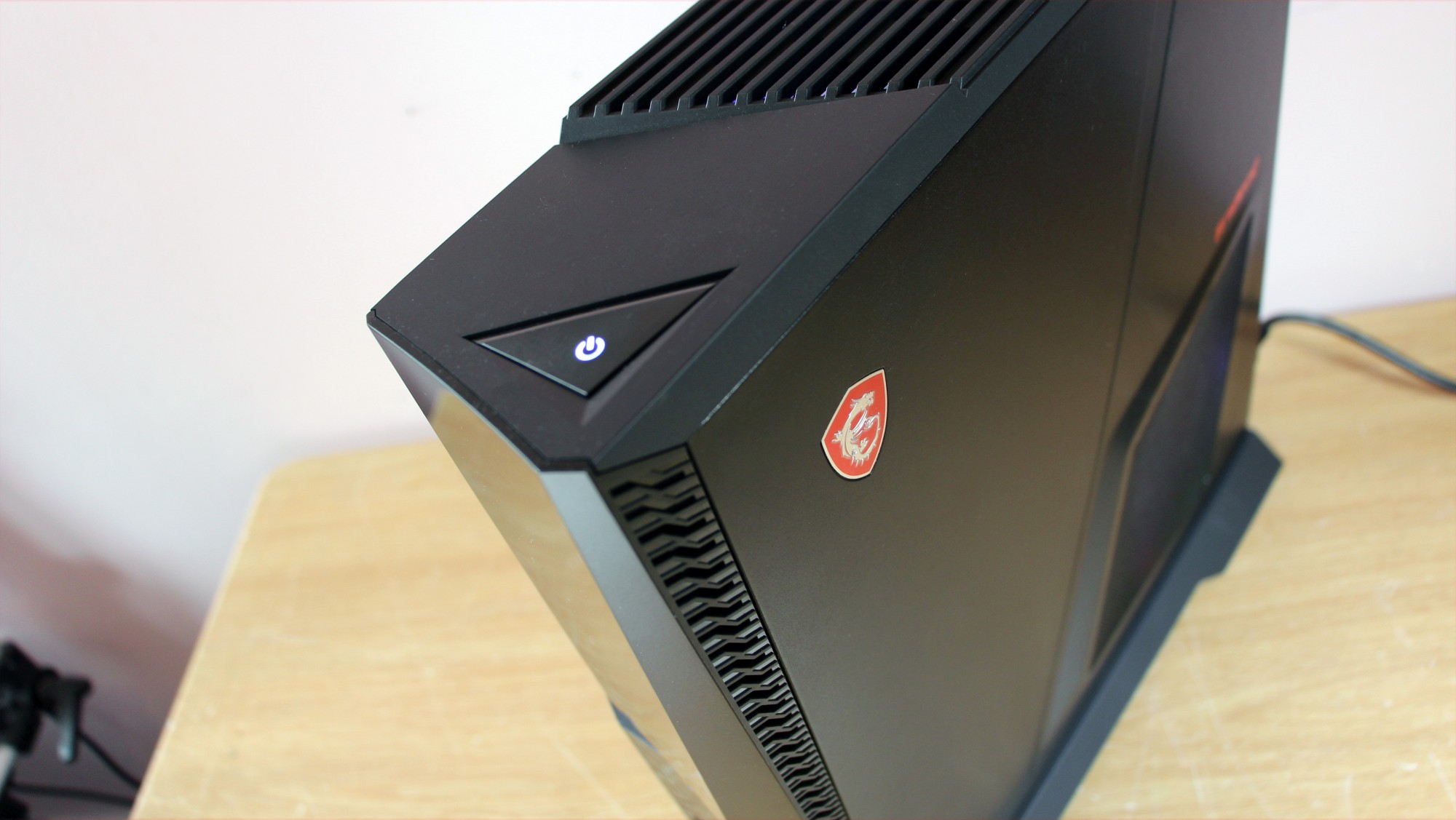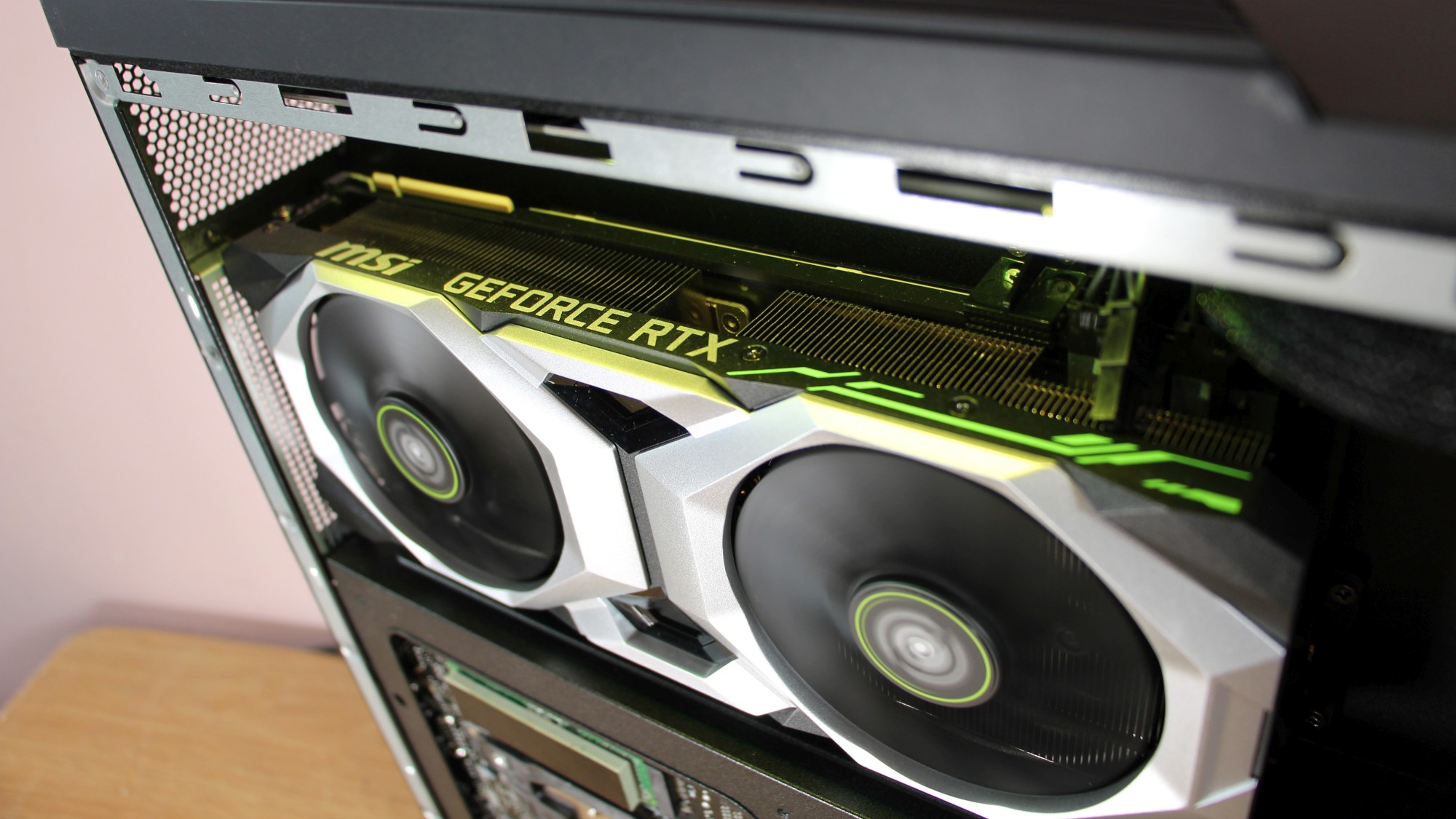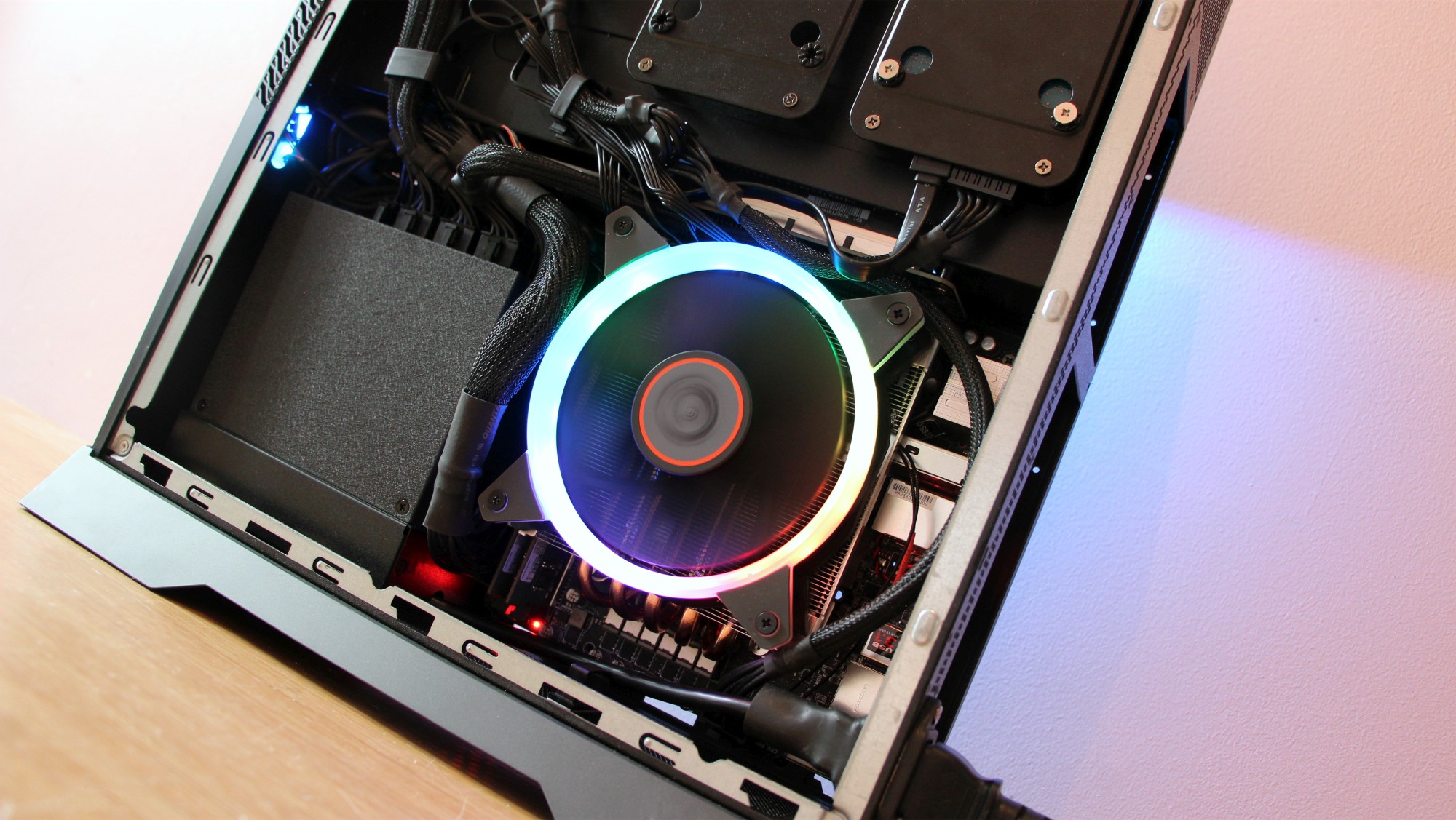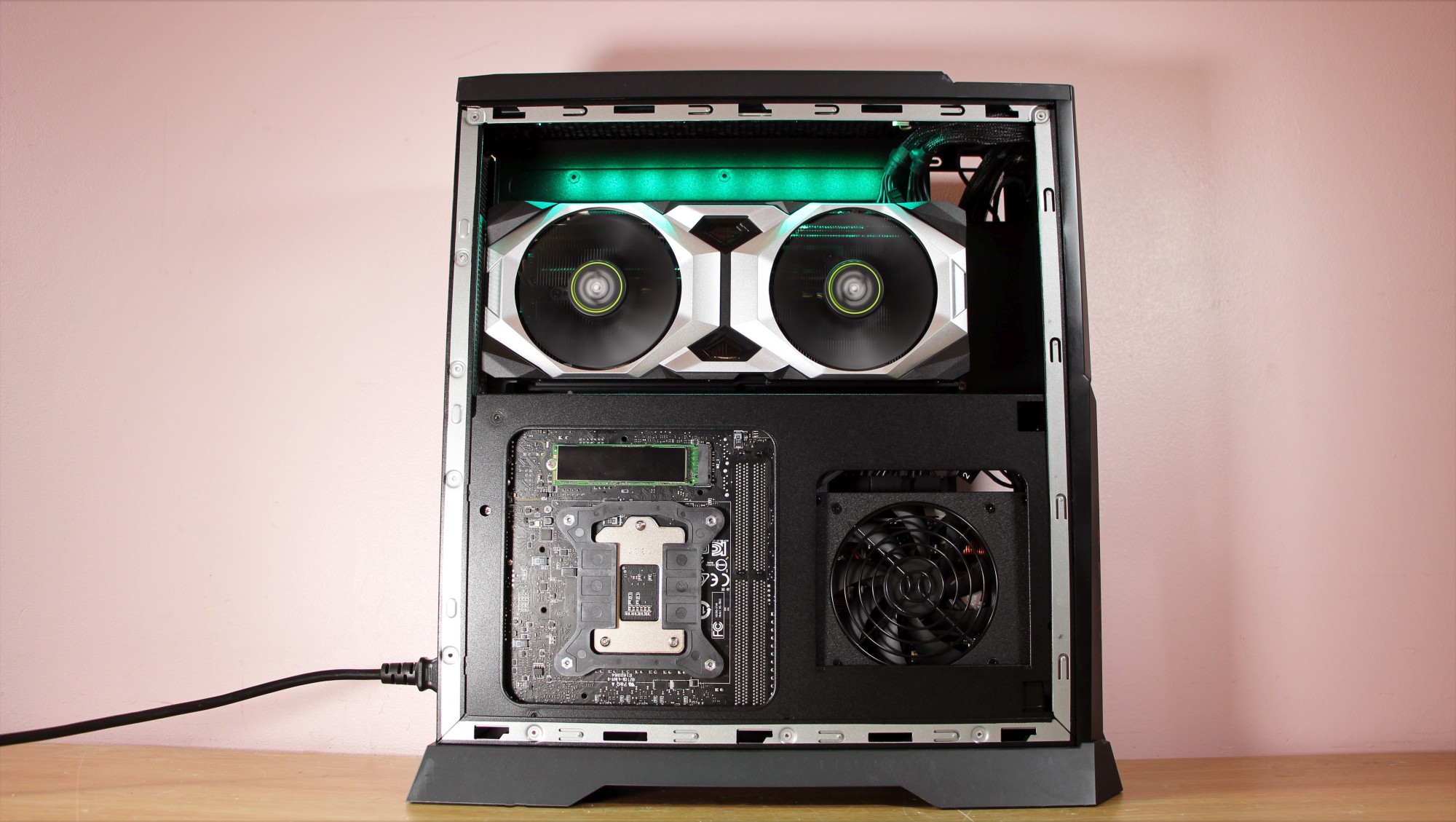MSI Trident X
The MSI Trident X is a small machine that packs in a surprising amount of new technology. Gaming grunt comes from one of Nvidia’s new Turing graphics cards, and processing power is delivered by one of Intel’s brand-new Coffee Lake-S processors.
Those are formidable core components, but the Trident X isn’t cheap - it’ll set you back $3,700 (£2,900, AU$5,200).
Price and availability
The $3,700 (£2,900, AU$5,200) MSI Trident X is only available in the configuration that we’ve reviewed here, which is a little irritating – we would have preferred a pricier model with the RTX 2080 Ti, and a more affordable machine with the RTX 2070 wouldn’t have gone amiss either.
MSI could also include lesser CPUs for those who aren’t fussed about having a high-end, eight-core chip.
It’s also worth remembering that buying from a local builder will save cash. If you opt for a smaller machine from a company like Chillblast or CyberPower then you can save a few hundred pounds or dollars.
If you’re willing to have a full-size tower, you’ll probably save a little more – and net yourself a bigger motherboard with more features and more upgrade room across the whole PC.

Design
The Trident X is a narrow, eye-catching system, with glowing RGB LEDs and angled panels. The front has full-size USB ports and a handy Type-C connection, and the Trident’s 14.3 pound (6.5kg) weight means it’s relatively easy to carry to gaming events.
It’s larger than the older MSI Trident 3, but it is smaller and lighter than two other key rivals – the MSI Aegis 3 and the Alienware Aurora R5 were heavier and chunkier. It’s also a lot smaller than a full-size gaming PC.
One side of the machine is dominated by the graphics card. It stretches across the whole width of the system, with meshed areas in the side panel to aid airflow. Below that you’ll find the rear of the motherboard, and the Samsung M.2 SSD.

Behind the opposite side panel are more components. Here you’ll find the storage, motherboard and power supply, along with the majority of the cables. The cabling and large, low-profile 120mm CPU cooler means that it’s difficult to reach the motherboard, and the only expansion option is a 2.5in drive bay - and it’s tricky to use because MSI hasn’t installed a SATA cable.
This is a not a machine to buy if you want to tweak and change your specification, but that’s the same with every mini-ITX PC - including rivals. It's an inevitable compromise.

The other issue is build quality. The plastic slats on the top are flimsy, and the side panels are made of relatively thin metal. The tempered glass panel that MSI includes in the box is stronger, but we’d still be careful when taking the Trident to gaming events.
Intel inside
The Core i7-9700K is one of Intel’s new Coffee Lake-S chips. These parts retain the same architecture as last year’s Coffee Lake chips, but with notable changes to core counts and clock speeds.
The i7-9700K has eight cores, but no Hyper-Threading – so it’s configured differently than the i7-8700K it’s replacing, which had six cores with Hyper-Threading. It makes sense, because native cores will always function better than the artificial Hyper-Threading system – and hardly any consumer applications need more than eight cores or threads anyway.
The i7-9700K runs at 3.6GHz, which is 100MHz slower than the i7-8700K. However, the i7-9700K’s eight cores hit 4.6GHz on Turbo, with one core topping out at 4.9GHz. The older chip could only manage 4.3GHz across all cores and 4.7GHz on one core.
The MSI Trident 3 and Aegis machines use Core i7 chips from the Kaby Lake and Coffee Lake ranges – so you get fewer cores, but with Hyper-Threading. The Alienware Aurora also uses Coffee Lake.
Performance
The Coffee Lake-S chip inside the new MSI is superb. Its Cinebench score of 1,470cb is almost double the pace of the MSI Trident 3 and Alienware machines, and it’s more than 300 points beyond the MSI Aegis 3 and its Core i7-8700.
The gap was maintained in Geekbench 3. The Trident X’s single- and multi-threaded results of 5,868 and 27,594 are stellar. The MSI Aegis 3 is the nearest challenger, and that was five hundred points behind in the single-threaded test and four thousand points back in the multi-core benchmark.
Having eight cores without Hyper-Threading but with better Turbo speeds clearly gives Coffee Lake-S the edge when compared to six-core chips that are Hyper-Threaded. That’s because eight native cores will perform better in applications than six cores that are handling twelve threads. That’ll make a real difference in day-to-day use, where few applications – or even groups of applications - need twelve threads to function well.

The Coffee Lake-S won’t bottleneck games, and it’ll handle day-to-day computing with ease. It’ll also run the vast majority of productivity applications, from video editing to streaming and content creation. The only software that won’t run well are tools that need proper workstation CPUs.
The factory-fresh CPU is joined by an Nvidia Turing graphics card. Despite its name, the RTX 2080 is designed to replace the GTX 1080 Ti. It has the new architecture’s improvements to integer, floating point and shader performance, and it includes a mighty 2,944 stream processors, 8GB of GDDR6 memory and a clock that starts at 1,515MHz and boosts to 1,710MHz.
It’s a great specification, but a question mark still hangs over Turing because of its headline features. Ray-tracing won’t work until Microsoft’s DX12 update arrives, and super-sampling needs to be implemented on a game-by-game basis.

Nevertheless, the GPU is no slouch. It zipped through our conventional 1080p tests with averages beyond 100fps in Deus Ex and Middle Earth: Shadow of War. The RTX 2080 has the power to handle 4K gaming, too: it ran through those two games with 4K averages of 40fps and 57fps.
It’ll play today’s top games at 4K, on widescreen panels and on VR headsets. The RTX 2080 may struggle with 4K gaming in the future or with graphics settings turned up in a handful of games, but you’re rarely going to hit issues.
The RTX 2080 destroys the GTX 1070 and GTX 1070 Ti cards that are used in most small form-factor gaming PCs. The Turing card scored 9,950 points in the 3D Mark Time Spy test. That’s nearly 4,000 points better than the GTX 1070 and about 3,000 points quicker than the GTX 1070 Ti.
Despite the power on offer from the CPU and GPU, the Trident X never performed badly in thermal tests. Its peak CPU and GPU temperatures of 81°C and 67°C are absolutely fine, and the MSI never proved loud – it produced a modest rumble that’s easy to mask with speakers or a headset.
The rest of the specification is fine. The Samsung PM981 SSD is reliably fast, with read and write speeds of 3,361MB/s and 1,906MB/s – quick enough to deliver rapid boot and load times. The 32GB of DDR4 is enough for work and overkill for games, but its 2,666MHz speed is mediocre.
The components attach to a modified version of an MSI Z370i Gaming Pro Carbon motherboard that has been stripped of its RGB LEDs and snazzy heatsinks – not an issue in a PC that’s so locked-down.
Verdict
The new components deliver formidable performance. The Turing GPU pelted through games benchmarks with enough grunt for 4K and VR gaming, and for playing titles at extremely high refresh rates. It’s only going to get better as driver updates appear and the new features arrive.
The Coffee Lake-S CPU outpaces its predecessors while delivering enough power for almost every task, and the rest of the specification is fine.
The chassis is small and smart, with good thermal performance, plenty of ports and RGB LEDs. That makes it an ideal system for taking to LAN parties.
However, while the Turing GPU is fast, its headline features don’t yet work – and these cards remains a risk. There’s no way of knowing whether ray-tracing and super-sampling will transform games – or not be properly utilised.
Elsewhere, the MSI Trident X doesn’t have the best build quality. There’s little room to upgrade on the inside, which is cramped and crammed with cables.
The price is high, too. If you don’t need quite this much CPU or GPU power, it’s very easy to save money by opting for a machine with lesser components – and they’ll still handle games in the majority of resolutions and situations.
Overall, the MSI Trident X’s new components deliver exceptional speed in all situations – certainly more pace than we’ve seen from mini-ITX machines in the past. The rest of the specification is fine, and there isn’t much that this machine can’t do. The chassis looks good, and it’s cool and quiet.
Build quality is suspect, though, and there’s no room to grow here. It’s expensive, too. However, if you’re feeling flush then there’s no better way to get your hands on a small PC with a shedload of computing ability.
0 comments:
Post a Comment